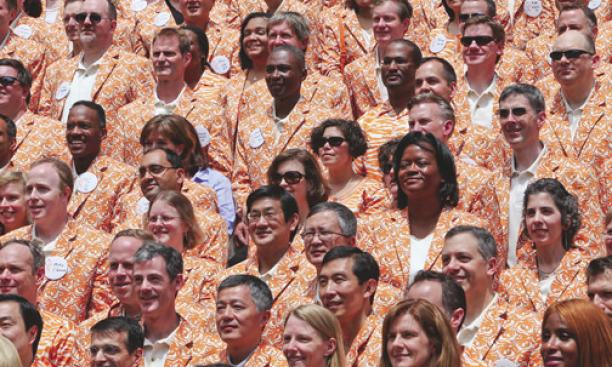

The Aspire campaign came to a resounding close on June 30, and words cannot fully convey my gratitude to everyone who had a hand in this achievement. Five years ago, I invited Princeton’s alumni, parents, and friends to come together in pursuit of our highest aspirations; to help our faculty and students “to excel and invent, to imagine and discover, to connect and thrive” in order to make our world a better place for all. A great university requires great resources if it is to sustain its longstanding strengths while advancing the frontiers of knowledge, and you responded to this challenge with exceptional enthusiasm and generosity.
Thanks to you, we exceeded our $1.75 billion goal, raising the largest sum in Princeton’s history despite the worst financial crisis since the Great Depression. Altogether, we received 271,559 gifts, totaling $1.88 billion, from Tigers of every stripe — an unparalleled investment in our future that is already paying dividends on campus. But before I touch on the multifaceted impact of these gifts, I would like to share with you another and, to my mind, even more important figure.
In the course of the Aspire campaign, 64,963 individuals, representing no less than 77.3 percent of undergraduate alumni, made a gift to Princeton, a level of participation that other universities can only dream of equaling. Annual Giving, an integral part of the campaign, set its own records, both in terms of total gift amounts and the participation rates of undergraduate and graduate alumni and parents. Equally impressive was the army of volunteers — 8,338 strong — who engaged their classmates and other members of the Princeton family. Superbly led by campaign co-chairs Bob Murley ’72 and Nancy Peretsman ’76, this collective effort not only addressed our University’s foremost needs, it also enlarged the metaphorical tent in which Princetonians gather.
Take, for example, Connect: A Black Alumni Leadership Initiative, led by Brent Henry ’69 and Dennis Brownlee ’74, who described its mission as follows: “We have to take ownership of our Princeton and give back, for the sake of the students who are here now and the students yet to come.” And that, in essence, is what this campaign was all about: ensuring that alumni remain invested in their alma mater and connected with each other in order to give succeeding generations the finest education that any university can offer.
One advantage of multi-year campaigns is that they allow an institution to set ambitious goals and achieve them in “real time,” putting gifts to work long before the final totals have been tallied. Princeton is already a different place from what it was five years ago, and not just outwardly, tempting though it is to look no further than a reimagined Butler College, graceful Streicker Bridge, the mirror-like walls of Sherrerd Hall, and a much improved athletic infrastructure. This, however, is just the tip of the iceberg. In terms of our core mission of teaching and learning, the Aspire campaign has generated 26 endowed chairs, 120 undergraduate scholarships, 25 graduate fellowships, and the endowment of a major pedagogical initiative in the form of the Keller Center for Innovation in Engineering Education — the very first gift we received. I am enormously proud of the fact that even in difficult times we were able to bolster our financial aid program, ensuring that we did not lose a single student because of economic hardship.
In four key areas — the creative and performing arts, engineering and environmental science, neuroscience, and the international arena — P rinceton has been forever changed. The Lewis Center for the Arts and the Andlinger Center for Energy and the Environment have breathed new life into their respective fields even before they make their physical presence felt at the intersections of Alexander Street and University Place and Olden Street and Prospect Avenue. At the Princeton Neuroscience Institute — soon to share a state-of-the-art facility with the Department of Psychology — three major centers have been formed, a Ph.D. program has been launched, and nearly 200 undergraduates have earned certificates since 2007. In disciplines stretching from engineering to economics, pressing global problems are commanding new attention through our multidisciplinary Grand Challenges initiative and a number of newly endowed centers, while two major innovation funds are supporting speculative but potentially transformative research.
Last but not least, Princeton is becoming a truly global university in which students have more opportunities to immerse themselves in other cultures than ever before, thanks, in part, to our groundbreaking Global Seminars initiative and Bridge Year Program. At the same time, our faculty are receiving the support they need to forge new — and very fruitful — relationships with colleagues overseas, and junior and senior scholars from around the world are being brought to Princeton through formal programs designed to increase the number and range of international voices on our campus.
In short, the Aspire campaign — and the devotion to Princeton it embodies — has allowed us to be an even stronger University, both for our faculty and students, and for the nation and the nations that we ultimately serve. Thank you, one and all!
